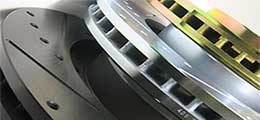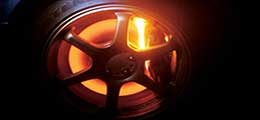Installing a set of performance brake rotors can be straightforward if you understand the basics. Here’s a step-by-step guide to help you get it right, especially if you’re working with our high-quality, direct-fit aftermarket performance brake rotors, machined to-order right here in California.
Understanding Brake Rotor Types
Straight Vane Rotors: Most stock brake rotors have a straight vane design. These are cost-effective and adequate for non-aggressive driving styles. The orientation doesn’t matter when installing these rotors.
Curved Vane Rotors: These are typically directional and must be installed on the correct side of the vehicle. They use centrifugal force to create a vacuum that pulls air through the rotor, cooling it more effectively. Installing them incorrectly will negate their benefits. However, it’s important to note that not all curved vane rotors are directional. For example, some Mercedes models use curved vane rotors that are non-directional, meaning the same rotor can be installed on both sides of the vehicle. In these cases, the orientation of the vanes will be opposite from each other on each side.
Pre-Installation Checks
- Quality Control: Before installation, check the new rotors for any surface defects or excessive run-out. Each manufacturer provides guidelines for these checks.
- Rotor Orientation: Ensure you understand the design of your rotors. For directional curved vane rotors, make sure they are installed on the correct side of the vehicle.
Installation Steps
- Remove the Old Rotors: Safely lift the vehicle and remove the wheels. Unbolt the calipers and slide off the old rotors.
- Inspect and Clean: Check the caliper brackets and clean the hub surface to ensure a smooth fit for the new rotors.
- Install the New Rotors: Place the new rotors onto the hub. If you’re installing curved vane rotors, double-check the orientation.
- Reattach the Calipers: Bolt the calipers back in place, ensuring they are secure.
- Test the Brakes: Before driving, pump the brake pedal to ensure the pads are seated correctly against the rotors.
Special Considerations for Drilled and Slotted Rotors
Drilled and slotted rotors often have specific installation requirements. The drill sites and slots may run in the opposite direction of the vanes, so always verify the correct orientation before installation. For instance, the slots should lean toward the back of the car if they are machined in the same direction as the internal cooling vanes, and toward the front if they are machined in the opposite direction.
Final Tips
- Hire a Professional: If you’re unsure about any part of the installation process, it’s best to hire a qualified mechanic.
- Regular Maintenance: Keep an eye on your brake system and perform regular maintenance to ensure optimal performance.
By following these steps, you can ensure a successful installation of your performance brake rotors, enhancing your vehicle’s braking efficiency and safety.









